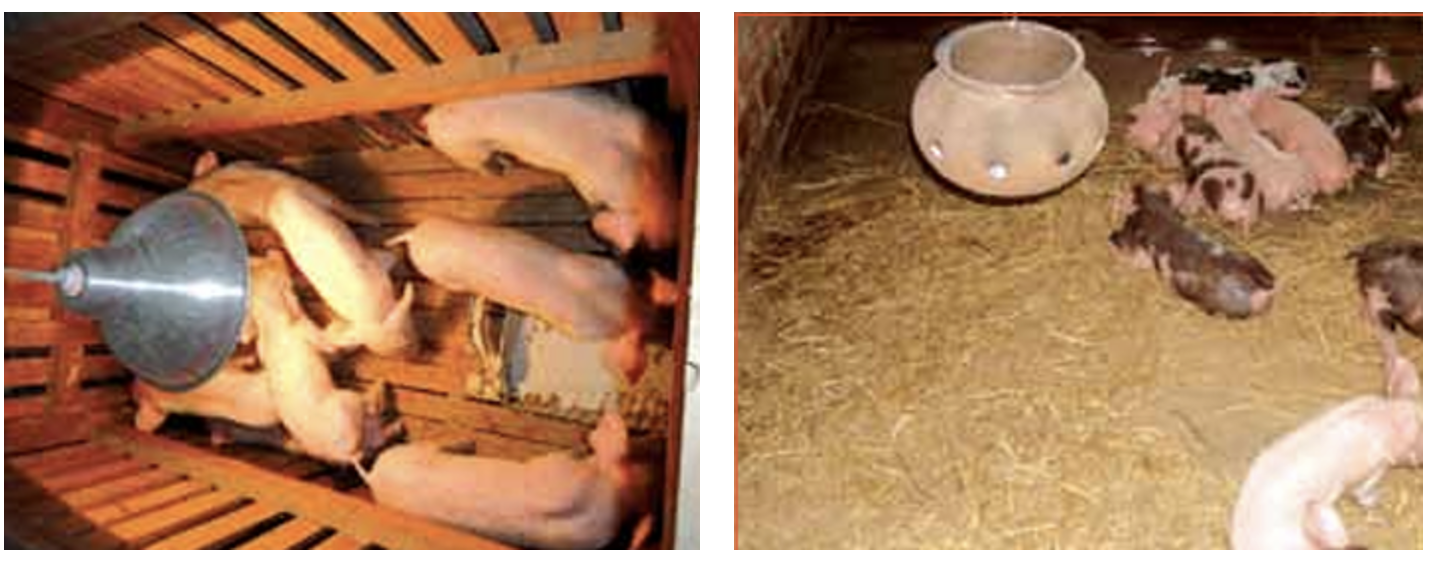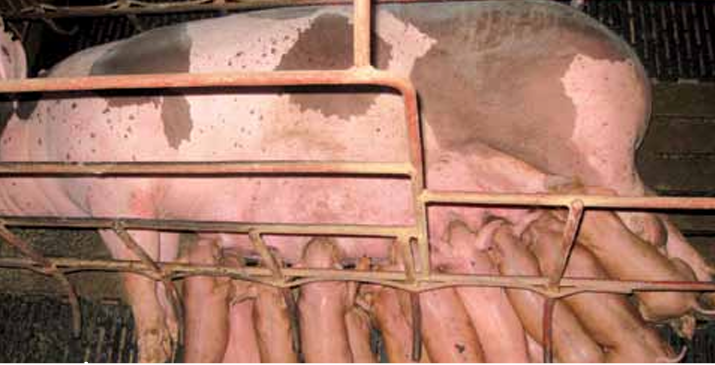

• Make sure the sow has enough milk for the piglets.
• Check the sow udders at least twice a day.
• If it is lumpy and hot, the sow udder may be infected (mammary gland disease, milk loss, uterine inflammation).
• In this case, must urgently treat the sow with oxytocin, 0.5 ml intravenously (CC) along with trimethoprim plus sulfa (Septotril, Trisulmex, etc.) for 3 consecutive days.
• At the same time, if the nipple capsule is hard, use dexametazon, and if the sow temperature reaches 40 degrees Celsius, inject more anazin to lower the temperature (use anazin at rate of 3-4 cc per 100 kg of weight).
• If possible, call a veterinarian to rescue due to the piglet needs milk.
• Newborn piglets need clean, dry, and space for roam around in, near a farrowing stall or warm crate to keep them healthy, avoid diarrhea, and protect weak piglets from death.
• Preparing the nest, heating the piglets with electricity or placing charcoal in an earthen pot that provides warmth for the newborn piglets is important.
• The place should be heated to 37 degrees Celsius for the first 4 days of life. The piglet box is 0.5 meters by 1 meter.
• A comfortable place for piglets is a dry floor with a heating pad, which can be a charcoal stove, gas stove lamp, or a 75-100 watt electric lamp, 0.5 meters height that not to burn the piglets.
• Piglets dying because of sow grinding are not uncommon and need to be care from the farmer.

Figure: Heating piglets with electricity and charcoal in clay pots
• If the farm without farrowing cage, the piglet cage must have strong bars and 20 cm away from the walls (and 20 cm above the floor) to prevent the piglets from pressing against the walls.
• Insufficient heating causes the piglets bellies to become cold, which allow the growth of E. coli bacteria, which causes diarrhea to piglets.
• On the other hand, when the weather is cold, the piglets lose energy and become weak, unable to walk to the mother's teat, that cause piglets to die.
• Piglets need 7-9 milligrams (mg) of iron per day, but sows can only provide 1-2 mg to their piglet by milk.
• Therefore, piglets need an additional 6-7 mg of iron.
• Iron deficiency causes piglets to become anemic (lack of red blood cells), stunted, and diarrhea.
• To help piglets survive longer, healthier, and stronger, farmers should practice the following:
At 1st day age, inject amoxicillin (Longamox) or Amox. LA 0.5 cc to prevent germs from entering through the umbilical cord, teeth, and tail docking, preventing inflammation, joints, and intestinal prolapse (intestinal or hernia).
At 2nd days age, very important to inject iron to help piglets produce red blood cells to prevent anemia. 100 mg of iron per piglet, or generally 1 ml, depending on the concentration of the drug, by injected into the neck and repeated at 7-10 days age.
At 3rd days age, give 1 ml of Toltraceril (Becok or Anticok) orally to prevent coccidiosis disease (gray diarrhea), which is common in piglets aged 7-20 days. Piglets with this disease do not die, but they become thin and slow growth.
Pigs should be fed twice a day, and the feed should not be stale or spoiled with adequate drinking water, both in quantity and quality, should be provided regularly.
Providing quality feed to sow is very important.
The amount of feed needed is reduced on the day the sow gives birth until 1-2 days later.
Then, feed should be provided according to the needs of sow, according to the number of piglets in the litter and actual conditions.
On the birth day, do not feed the sow, but provide with enough water to drink.
On the second and next days, the pigs were gradually given more feed.
A pig needs about 2.00-2.50 kg of feed per day to maintain body weight.
For milk production and feed for piglets, an additional 0.25 kg is required for each piglet per day (referring to exotic or improved sow that have been given quality feed).
Example: Feed for a sow with 8 piglets is to feed 4 kg per day: 2 kg + (0.25 kg x 8 piglets) = 2 kg + 2 kg = 4 kg per sow/day.

Figure: A sow breastfeeding piglets
• In cases the sow is not feeding, constipation, or fever, must be careful because the sow will not produce enough milk for piglets.
• The cause of constipation is that feed turns to sour in the intestines.
• Toxins are absorbed into the blood, causing problems with the milk.
• The sow udder becomes hot and hard.
• Diarrhea is the most serious disease that threatens the mortality of piglets.
• In less than 24 hours, the piglet will lose water intake.
• The solution is to use a medication to reduce dehydration (a little salt mixed with sugar) that can be given to weak piglets by syringe with or without a tube, or put in the feed if the piglet is able to feed itself.
• Piglet sterilization should be done on male piglets that are 7-10 days age because the piglets are still young, so the wound heal quickly and the piglets are still very strong by this stage the sow has enough milk.
• Before sterilization, we may inject anazin to relieve the pain and clean the skin of the testicles and the necessary equipment used, such as a knife, iodine, or alcohol.
• We need to sterilize the incision at lower part so that blood does not pool at the incision site.
• Using a sharp knife, cut one-third of the testicles, making a vertical cut in half of each testicle skin.
• Then, squeeze the testicles to push them out of the groin and pull them out.
• Cut the scrotum as short as possible and spray iodine solution into the surgical site.
• After sterilization, we can inject amoxicillin to prevent the penetration of germs and keep the piglets in a dry place.